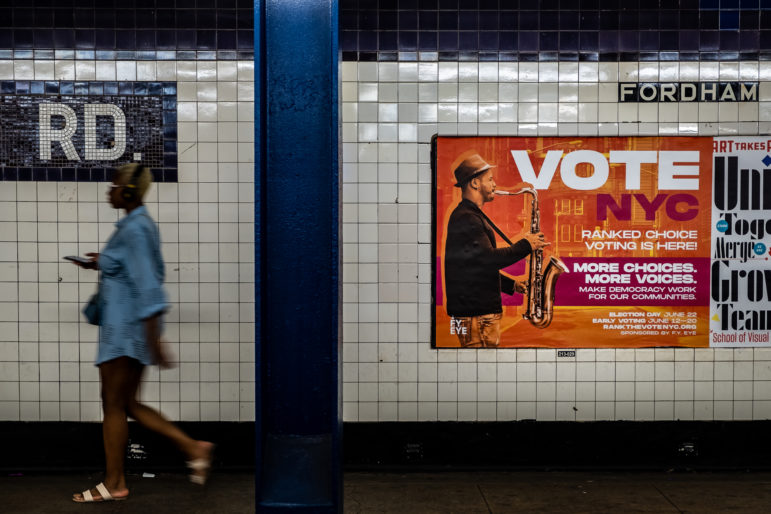“When voters voted for ranked-choice voting, we voted for it with the understanding that there’d be two years of city-wide education, which never came,” said Christian Amato, who has been polling Bronx residents on their awareness of the ranked-choice system.

Adi Talwar
A get-out-the-vote ad in the Fordham Road Subway Station.By now, many New Yorkers have likely heard about ranked-choice voting, the city’s newly adopted system of selecting winners in primary elections.
Instead of voting for one candidate in a given contest — like the mayoral, Comptroller, or City Council race — voters can now rank up to five different choices for each seat. Ranked-choice voting, which is said to improve the quality of elections by giving voters more choice, is already used in a growing number of jurisdictions around the country.
Critics of the new system say that despite a $15 million voter education push from the city — which includes what officials describe as “robust” advertising, multilingual resources and partnerships with community groups — the initiative is too little, and done too late to be optimal. The city announced its voter ed initiative in late April of this year, some pointed out, even though the ranked-choice voting referendum was approved in late 2019.
“When voters voted for ranked-choice voting, we voted for it with the understanding that there’d be two years of city-wide education, which never came,” said Christian Amato, Bronx-based founder and chief executive of Consense Strategies, which has been polling Bronx residents on their awareness of the ranked-choice system. “And you can’t make up for two years without education by throwing $15 million dollars out at the electorate.”
Mayor Bill de Blasio dismissed concerns about the timing of the initiative. “I am absolutely convinced the timing works because what I’m seeing all over the city is people have not been paying attention to this election yet, but this is the organic time where they will pay attention,” he said during remarks announcing the voter education campaign and the appointment of Chief Democracy Officer Laura Wood in late April. “And in fact, concentrating such a massive outreach effort in this space of time is the thing that will get people’s attention. We’re going to spend the money when it actually will be felt.”
The city has spent approximately $10.5 million on its media campaign, including $7 million on TV ads and $1 million on digital ads, a City Hall spokesperson told City Limits last month. Officials have spent around $2 million on direct outreach partnerships, which include collaborations with faith-based groups and minority- and women-owned businesses, the spokesperson said. Print and “out-of-home” outreach, which includes bus shelter and subway system advertising, cost approximately $600,000 and $500,000, respectively.
But even some of those who train voters on the system say the switch is likely to confuse and alienate some voters. Already, some New Yorkers who voted early have complained that informational materials on ranked-choice voting arrived after they’d cast their ballots — if at all.
“Ranked-choice voting is going to disempower and disenfranchise us, because they failed to properly educate our communities and educate voters, even though they’ve had over a year — pandemic or no pandemic,” said Mona Davids, who trains New Yorkers on the system through her consulting firm, Social Impact Strategies.
“Many of our workshop attendees are unfamiliar with ranked-choice voting,” said Davids, who has trained close to 1,000 city residents. “The most common question is, ‘When did this happen? Who decided this?’”
Davids, of the Bronx, was an initial opponent of the ranked-choice system, voting “no” on the 2019 referendum. Testifying before the City Council’s Committee on Governmental Operations in December, Davids criticized officials for not mounting an education campaign sooner.
“The same vigor that went into passing this new electoral system should have been applied to educating voters throughout the year,” Davids said in her Dec. 7 testimony.
Opponents of ranked-choice voting, including some city lawmakers, have even tried — unsuccessfully — to sue to stop its implementation, claiming, like Davids, that it would unfairly disenfranchise some voters.
Still, other organizations say that they have managed to reach these voters and teach them about the new electoral system.
“The $15 million effort has helped tremendously,” boosting the reach groups have been able to have, said Debbie Louis of Rank the Vote NYC, one of the groups that is collaborating with NYC Votes. Her organization has reached thousands of voters, she said, including 150,000 in one May weekend.
“Although I know some folks love or hate ranked-choice voting, I do think we’ll understand more of this process after we see what it does in our city,” she added.
It appears that there may still be challenges to the system coming after the Tuesday election. The city Board of Elections may issue preliminary results in races using ranked-choice voting on Tuesday night, but absentee ballots must be counted before a final vote count — and certainty on who wins or loses key contests — can be offered. The process could take weeks.
Already, the delay is drawing criticism from some candidates for mayor, including Brooklyn Borough President Eric Adams, who said on Sunday that it might prompt New Yorkers to suspect “hanky-panky.” Adams later said he would respect the Board of Elections process.
Read more:
How Will Ranked-Choice Voting Work in NYC? Let’s Pretend.
How Ranked Choice Voting is Changing the Endorsement Game in NYC Elections









